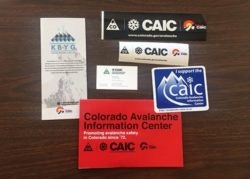Avalanche Safety
By admin Published January 12, 2017
Avalanche Safety
Year after year, hundreds of people – skiers, snowboarders, snowmobilers, snowshoers, etc. – find themselves caught in an avalanche. Avalanche terrain is any snow-covered hill, mountain, or slope steeper than about 30 degrees. It doesn’t matter if the slope is big or a very small. Also, it doesn’t matter if it is an open slope or one with trees. In general, avalanche activity peaks during winter storms or during the 24-48 hours following one, but some avalanches can be triggered weeks after a snowfall event. Because avalanche conditions can change rapidly it is important to check current conditions and get avalanche danger ratings from your regional avalanche center. You can find the most recent forecast at the Colorado Avalanche Information Center.
There are five basic steps to take and things to consider during the winter months to avoid getting caught in an avalanche:


- Get the gear: Carry a beacon, probe, and shovel and understand how to use them. Make sure your team also know how to use them so they can find you and help in the case of an avalanche. A more modern piece of equipment is the avalanche airbag. This airbag is designed to keep you on top of the slide instead of buried under it. Finally, don’t forget the most basic component – a helmet.
- Get the training: Experience is critical. Taking a field-based avalanche course is the best investment you can make to improve your avalanche safety. Instructors can teach you how precipitation, wind, and temperature play roles in snow stability, and how terrain factors like slope steepness, orientation, and underlying rock affect conditions. Find classes that teach you how to use classic safety equipment, like beacons, probes, and shovels at www.avalanche.org and www.avtraining.org
- Get the forecast: Make sure you check local avalanche forecasts at www.colorado.gov/avalanche Pay close attention to winter storm forecasts and avoid terrain that receives a foot or more of snow for 24 hours. Check out the free avalanche awareness program, Know Before You Go.
- Get the picture: Make the observations. Have there been recent avalanches in the area? Be aware of cracks in the snow or whumpfing (sound collapsing snow makes). Heavy snow and strong winds are a good hint that there might be unstable snow conditions.
- Get out of harms way: Try to cross avalanche slopes a single person at a time. Don’t stop in areas exposed to avalanches, and avoid terrain traps like gullies and cliffs. Don’t enter closed areas and keep in voice and/or visual contact with your partners. If worse comes to worse and you are caught in a snow slide, try to escape to the side of the slope, grab a tree, or “swim” hard to try to stay near the surface of the slide. When an avalanche stops, the snow will quickly settle like concrete, so try to clear air space to breathe around your face and stick a hand upward and out of the snow if possible. If a member of your team has been involved in an avalanche – call 911, make sure it is safe to start a rescue, and keep everyone on site to help.
Despite the dangers, the appeal of fresh turns and promise of backcountry solitude will continue to draw people into avalanche terrain. Keep in mind that these rewards never come without risk.
Did you know? You can request a class for your school or function at Colorado Avalanche Information Center KBYG Program. Get some education to get out and have fun safely.
If you are interested in taking some avalanche awareness gear home with you – stop into the Carbondale Fire Headquarters today!
